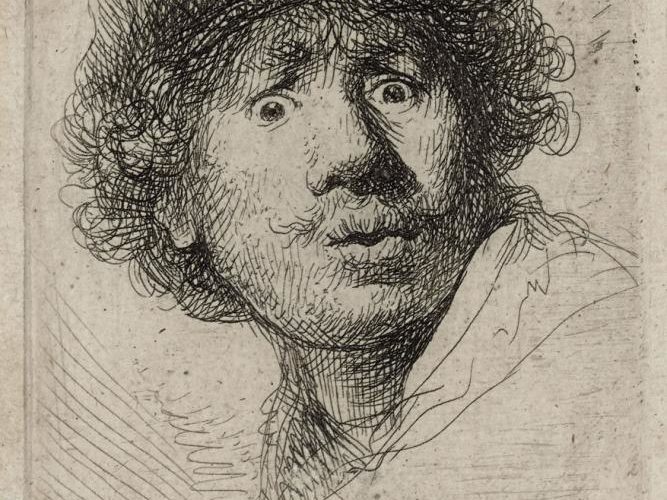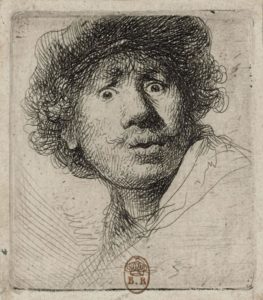Rembrandt Harmenszoon van Rijn was one of the greatest Enlightenment painters. He died 350 years ago this month at the age of sixty-three.
In the thirteenth and fourteenth centuries the Flemish cloth trade had developed into the strongest competitor of Florentine cloth-makers and traders, giving rise to a growing Dutch bourgeoisie. Early capitalism developed quickly in Flanders and Brabant, with their trading centre of Antwerp, while the provinces in the French-speaking area remained agricultural and dominions of the nobility.
The conflict between bourgeoisie and aristocracy became an expression of national interests, reflected in the struggle against Spanish domination. The bourgeoisie was the leading force in the national liberation struggle of the Dutch people.
Only the northern provinces of the Netherlands succeeded in freeing themselves from Spanish rule, in 1648, giving power to the bourgeoisie. Awakened national pride and love of the homeland as well as pride in bourgeois prosperity were all expressed in painting. Dutch artists painted everyday life and ordinary people at work. They raised genre painting to the level of great art, and for the first time in history ordinary people were painted in all their diversity. Dutch art was the first to develop secular genre painting.
Cheerful aspects of life dominated the arts. The peasant world was also included, though mainly for amusement. Soldiers and beggars completed the range of subjects. The only painter who expressed a warm humanity for beggars was Rembrandt. His genius was unrecognised in patrician Holland, yet only Holland could produce such an artist. Only the Republic that had a plebeian history linked to the struggle for independence could be his historical ground.
Rembrandt’s art
The young Rembrandt’s paintings are full of joyful energy, as his Self-portrait with Saskia (1635) shows. Towards the end of the 1620s his art had grown—in warm, gold-tinted coloration and in its ability to dramatise space through light-dark contrasts.
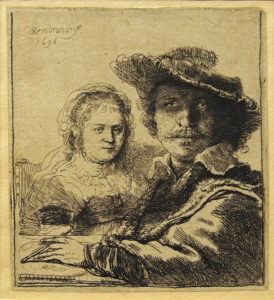
The Night Watch (1642) was a new departure. Group portraits had become a special achievement of Dutch art, expressing proud community spirit. People wanted to see the members of a guild or a corporation represented together. The civic militia, organised in militia guilds, played an important role in the wars of independence, making such paintings artistic expressions of the bourgeois revolution. Rembrandt broke with the traditional style of a fairly stiff group portrait by subjecting all participants to dynamic action and with a dominant light-dark contrast.
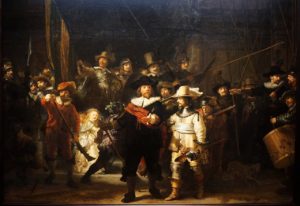
Rijksmuseum, Amsterdam
Instead of an impressive company of admirable officers and disciplined men, Rembrandt paints a rather disordered assembly. Each guard seems to be looking and pulling in a different direction, doing his own thing, impervious to the others. Lance and flag point in opposite directions. In the midst of it, a diminutive golden figure with the features of Rembrandt’s recently deceased wife, Saskia, holds the company’s emblems.
In this way Rembrandt subverts what had been a heroic genre. There is liveliness, sound, and motion, with a man loading his musket, the commander giving orders, a drummer drumming, a flag swung, a barking dog, and the boy carrying a powder horn dashing off to collect more powder for the three musketeers—all adding to the commotion.
Two areas of bright gold on either side of the captain focus the eye on him, as do the diagonal lines of the flag, rifle, and lance, all pointing towards the same figure. Nevertheless the captain and his lieutenant in the centre foreground do not impose order.
This animated, energetic movement was so new that it must have perplexed both guild and viewers. It is so powerfully forward-moving that the viewer feels a need to get out of the way. It is a revolutionary painting.
Later Rembrandt developed a lyrical intimacy that infuses family scenes with a humanity that constitutes his timeless significance. The moving painting of Jacob Blessing the Sons of Joseph (1656) uncovers depths of the human psyche and finds its greatness in love and forgiveness. Colour and light interweave to make the innermost glow. Rembrandt focuses on the gentleness and warmth of Jacob’s blessing, not showing the disagreement between Joseph and Jacob regarding this blessing.
Also, the inclusion in this scene of the children’s mother, Asenath, is a deliberate departure from the Bible and reflects the growing status of women in seventeenth-century Holland as well as the importance of love in marriage. Asenath is shown to be involved and an important figure in the family setting. Her presence illustrates Rembrandt’s realism and the ingredient of doubt that he brings to his art. The painting’s colours underline the warmth and tenderness of the scene; the perspective in which it is painted heightens the sense of the viewer surreptitiously witnessing a momentous family moment.
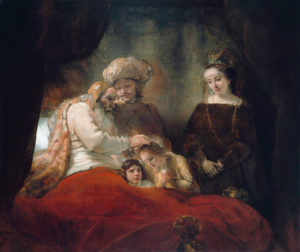
Gemäldegalerie Alte Meister, Kassel
In the course of Rembrandt’s lifetime the bourgeoisie had aligned their standard of living with that of the nobility. They became mainly interested in the outwardly beautiful and representative. Rembrandt’s incorruptible artistic honesty, shaped by the democratic spirit of republican Holland, inevitably came into conflict with the ruling class. From the middle of his life his work was no longer valued.
Rembrandt anticipated a democratic culture that was yet to come. He was the first to place modern knowledge, understanding and therefore doubt at the centre of his art. This places him in the ranks of the great Enlightenment artists and thinkers, and thereby connects him with the ideas of the French Revolution.
All but forgotten in old age, Rembrandt van Rijn died alone and in poverty on 4 October 1669.

